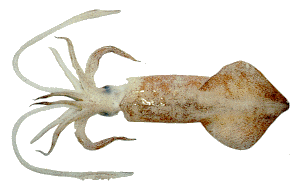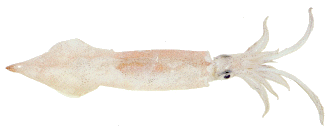Links
Commercially
Harvested
A= Aquaculture
Information
Family: Octopodidae

- Greek restaurants sometimes serve pickled octopus, called octopothi.
- Tako poke- Hawaiian Style
- The octopus's diet of clams and scallops gives it highly flavorful meat that, though rubbery, is extremely popular in Japan and the Mediterranean countries.
- Live or Fresh dead, frozen,salted or in brine
- Tips: As with most mollusks, younger and smaller octopus is tastier and more tender than older, larger ones. The eight tentacles and body of the octopus are edible, but the eyes, mouth area, and viscera are not. Octopus can be prepared raw, boiled, pickled, grilled, or sautéed.
- Ceph Base
- Am. Octopus, Fr. Poulpe, Es. Pulpo, Japan Ma-dako tako
- Cistopus indicus
-
Octopus aegina Gray
-
Octopus cyanea
Hawaii: (he'e mali, Day Squid)
Hawaii
- Octopus dofleini (Pacific Giant)
- eledone species
- Octopus macropus Risso
- Octopus marmoratus
Hawaii: (he'e puloa; Night squid)
URL
- Octopus octopus species
URL
- Octopus ocellatus
URL
- Octopus variabilis
URL
- Octopus vulgaris
(Cuvier, 1797)
W Mediterranean Sea
Links
Commercially
Harvested
A= Aquaculture
Information
Family: Loliginidae
the Squids

URL
Ceph Base
- There are more than 300 species of squid that inhabit the world's
oceans, but fewer than a dozen of these comprise about 90 percent of
the global catch. Of these, three comprise the
domestic suppy.
- West Coast "market squid" (L. opalescens) are 3 to 5 inches long
- East Coast squid, including long-finned "winter squid" (L. pealei)
- short-finned "summer squid" (L. ssp. Illex illecebrosus)
- Because the domestic market prefers a white-meated product, squid are sometimes "bleached" in a brine solution to enhance whiteness.
- Cooked squid is mild and has a subtle sweetness. The meat is firm yet tender.
- fresh squid is often eaten ink and all and is referred to as a "Dark Dish"
- Doryteuthiis sibogae
URL
URL
URL
URL
- Loligo duvaucelii
URL
URL
URL
URL
- loligo gahi
URL
URL
- Loligo japonica
- Loligo spp, Illex illecebrosus
California, Monterey, San Pedro or market squid, summer squid

Peru, Taiwan
USA
- The Illex squid has large, 8- to 12-inch tubes and is coarser than loligo. Raw squid meat is ivory beneath a naturally speckled membrane. Cooked squid is opaque white and firm. Fresh or thawed squid should be moist, shiny and ivory colored. Pink, yellow or purple flesh indicates deterioration.
- The edible parts of the squid include the arms (tentacles), the mantle (tube) and the fins (wings). The body is covered with a thin skin that may be removed before cooking. Squid ink is often used to make black pasta.
- Beware: lower-value
illex is sometimes substituted for the more desirable and expensive
long-finned loligo. Illex is larger and coarser than loligo.
In recipes, Monkfish medallions, Bay scallops and Halibut cheeks can be used as a substitute and passed off as squid. - Preparation
& Cooking: The secret to tender squid is to cook it either quickly
or for around 30 minutes. Rings can be battered and fried; mantles can
be stuffed and baked in a sauce. Don't overcook, or squid will turn
as tough as a pencil eraser (a couple of minutes are usually enough).
If you do overcook, keep cooking for 20 minutes more, and it will become
tender again. Braised or baked squid should be cooked this long anyway.
- Loligo opalescens
Opal squid, Market Squid
- loglio vulgaris (Common squid)
- loglio pealei
long-finned "winter squid"
URL
URL
- Ommastrephes
bartrami
(Brodeur and Ware 1994)
Neon Flying Squid
URL
URL
- Onychoteuthis
borealijaponicus
Nail squid
URL
URL
- Rossia Pacifica
Bobtail squid
URL
URL
URL
URL

Linne 1758
URL
URL
- is used as a food source by the people on Negros Island, Philippines.
ORDER:Septoidea
the Cuttlefish

- Am.Cuttlefish, Fr. Seche, Japan Ko-ika, Es. Jibia,
- Cuttlefish and Squids of the World in Color
- Ceph Base: 118 Species
- Sepia esculenta
Steenstrup, 1881
URL
- Ceph Base
- Sepiadarium kochi Steenstrup, 1881
Bottletail squid
URL
- Syn: Sepiadarium malayense Robson, 1932
- Ceph Base
- Sepiella inermis
(Van Hasselt, 1835)
Spineless cuttlefish
- Sepiella microcheirus Gray, 1849
- Sepia affinis Eydoux/Souleyet, 1852
- Sepiella maindroni Rochebrune, 1884
URL